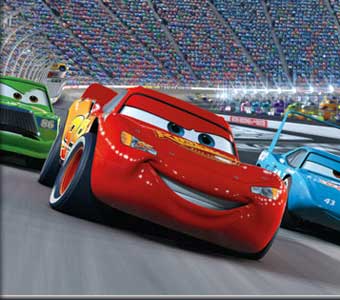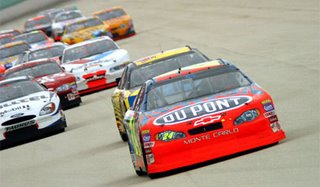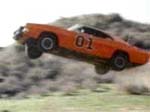Muscle Cars And The Movies
It’s bigger than baseball in America, and now it’s coming to a cinema near you. Nascar has become a cultural phenomenon, says Brian SchofieldIt’s just a kids’ cartoon about talking cars, right? A cocky roadster, voiced by Owen Wilson, learns the value of loyalty and trust from Paul Newman’s grizzled old banger, and everyone drives off into a Disneyland sunset? Cars, the latest CGI family multiplex-packer from the Disney-Pixar team that produced Toy Story, Finding Nemo and The Incredibles, sounds like simple enough fare, with the only subtext being the usual grown-up gags flying over the little ones’ heads.
 But look a little closer, at the carefully drawn muscle cars, the meticulously realistic racing lines and the packed asphalt oval where Lightning McQueen learns his uplifting life lessons in the final reel and, if you know your American pop culture, you will know you are not just watching a cartoon — you are watching Nascar. Or, for the uninitiated, you are witnessing another step in the bewilderingly successful campaign for stock-car racing to take over the world.
But look a little closer, at the carefully drawn muscle cars, the meticulously realistic racing lines and the packed asphalt oval where Lightning McQueen learns his uplifting life lessons in the final reel and, if you know your American pop culture, you will know you are not just watching a cartoon — you are watching Nascar. Or, for the uninitiated, you are witnessing another step in the bewilderingly successful campaign for stock-car racing to take over the world.Because, if the behind-the-scenes motorsporting contributors to this film (and other artistic endeavours, from the next Will Ferrell movie to the latest Rolling Stones video) have their way, it will not be long before the global pastime of bellowing at referees and being too scared to watch the penalties is replaced by the slightly less immediately attractive prospect of watching 35 men drive in a circle for three hours.< And don't think this is just about sport.
Nascar, you see, is a way of life. It’s practically a faith. And it wants to convert you. The acronym stands for the National Association for Stock Car Auto Racing, which began in the 1940s as an obscure caravan of car races in the southeastern USA, populated by drivers who had learnt their breakneck skills running moonshine whiskey through the Appalachian Mountains.
The fundamentals of the sport remain the same today — clean-cut good ol’ boys with aw-shucks grins and names like Greg Biffle, Chad Blount and, I kid you not, Travis Kvapil barrel around a banked oval track for up to 600 miles every Sunday in spring and summer, the winner determined by an indecipherable points system that does not necessarily involve actually finishing first.
What has changed, in the past 20 years, is the scale — as Nascar has become a cultural and commercial phenomenon unlike any other. More spectators parked their RVs, heated up their barbecues, cracked open a keg and watched the least popular Nascar race of the 2005 season than attended last year’s American-football Superbowl.
A single race meet, with at least 120,000 fans descending for the weekend (many Americans now plan their annual holidays around them) has been measured to have a greater economic impact on the surrounding community than hosting the Ryder Cup golf tournament. With 75m fans, Nascar is now more popular than baseball, supposedly America’s national pastime, and slam-dunks the once fashionable allure of basketball.
In March, a Nascar race was delayed because of rain, forcing Fox TV to air a 90-minute filler. At the same time, Los Angeles were playing Cleveland at basketball: which, as you may know, means Kobe v LeBron, the equivalent of Beckham v Rooney. The Nascar rain-delay show reportedly outpointed the basketball game by three viewers to one.
 And where the fans have gone, sponsorship has followed. McDonald’s, Pepsi, Coca-Cola, Betty Crocker: every all-American company you can think of has pumped $650m per year into getting logos onto bumpers, bonnets and baseball caps, making Nascar the USA’s richest sport.
And where the fans have gone, sponsorship has followed. McDonald’s, Pepsi, Coca-Cola, Betty Crocker: every all-American company you can think of has pumped $650m per year into getting logos onto bumpers, bonnets and baseball caps, making Nascar the USA’s richest sport.The $700m that the communications firm Nextel paid out to brand the race season for the next decade is the biggest sponsorship deal in world history. And the cash is worth splashing, as fanatically dedicated Nascar fans are reportedly twice as likely as any other sports fans to buy a sponsor’s product because they saw its logo on a side panel. It’s bewildering stuff — until you realise that this isn’t really about race cars.
Nascar’s allure has been almost all cultural — with a timely and tantalising vision of America highly visible in both the pit lane and the grandstands. John Lasseter, the director of Cars, said at the premiere (held, of course, at a North Carolina racetrack): “I’m not saying the modern world is bad, but ... it’s really great to slow down.” As perky as Happy Days characters, more liable to say “gee”, “neat” and “darn” than to demand a pay rise, Nascar drivers have ridden to stardom on a wave of popular suspicion that the swearing, drug-taking, law-breaking modern “urban” icons who have taken over much of American sport (not to mention music and television) are tarnishing the idea of national heroism.
The generous Nascar sponsor Budweiser recently captured the mood with a series of adverts featuring a fictional money-grubbing, overhyped American-football player called Leon.
 But Bud unwittingly caught the zeitgeist too well — Leon was black, and, almost without exception, Nascar drivers are as white as the Dukes of Hazzard. According to Joe Menzer, author of The Wildest Ride: A History of Nascar (or, How a Bunch of Good Ol’ Boys Built a Billion-Dollar Industry out of Wrecking Cars), Nascar’s owners are embarrassed about the lack of diversity on show: “They’re out there, looking for their Tiger Woods.” But the fans in the stands are not so shy. “You still get a lot of Confederate flags at the track,” he adds.
But Bud unwittingly caught the zeitgeist too well — Leon was black, and, almost without exception, Nascar drivers are as white as the Dukes of Hazzard. According to Joe Menzer, author of The Wildest Ride: A History of Nascar (or, How a Bunch of Good Ol’ Boys Built a Billion-Dollar Industry out of Wrecking Cars), Nascar’s owners are embarrassed about the lack of diversity on show: “They’re out there, looking for their Tiger Woods.” But the fans in the stands are not so shy. “You still get a lot of Confederate flags at the track,” he adds.You can put a positive slant on what Nascar represents — Dr James Wright, University of Central Florida sociologist and race fan, says the “instant camaraderie” of flaming grills and tailgate parties that characterises a Nascar race day is all part of the national renaissance of “family, community and spiritual values”. But it is hard to say that every colour and creed is welcome if only one tribe turns up: as Dave Caldwell, who covers Nascar for The New York Times, says: “It’s a white sport, and that’s not going to change any time soon.”
And the race track is not the only place where a more muscular, confident expression of white working-class culture has found its voice in America of late — picking up speed, not coincidentally, when a long-time race fan took control of the Oval Office, courting the economically challenged but morally upstanding demographic segment the pollsters labelled Nascar Dad.
Bass-fishing, of all things, is the fastest-growing TV sport in the States, with its own channel; the unreconstructed restaurant chain Hooters, which serves up red meat, cold beer and pert breasts throughout the week, though “the kids eat free on Sundays”, has expanded into the airline, hotel and casino businesses; while the Blue Collar Comedy Tour, consisting of four white men telling shamelessly redneck jokes, is the country’s most popular stand-up show, clocking up $12m so far in ticket sales, a hit DVD, an album and more.
One of the quartet, Larry the Cable Guy (sample joke: “Is that my shadow? I thought a couple black guys were sneaking up behind me”), has snagged a role as a tow truck in Cars. In all cases, the semblance of shambling, folksy amateurism is a country mile from the fiercely ambitious corporate reality — in which Nascar leads the pack.
Blatant in its desire to conquer every corner of pop culture, Nascar has hired Sarah Nettinga, a former Warner Bros executive, and opened a development studio in LA to help force its product into the global mainstream. Cars is the second Disney movie in two years with a stock-car plot (and, as part of a $4.5 billion TV rights deal signed in 2005, the Disney-owned ABC and ESPN channels will be showing Nascar races from 2007). The first, the clunky Lindsay Lohan vehicle Herbie: Fully Loaded, in which the Love Bug and the teen poppet teamed up to outdo Matt Dillon’s muscle car, was towed slowly into profit by race-fan loyalty last year.
Much more likely to secure global domination is this autumn’s Talledega Nights: The Ballad of Ricky Bobby, which has slipped into Hollywood lore by securing a deal with a six-word pitch: “Will Ferrell as a Nascar driver.” The red-hot Anchorman star plays an all-American driver whose champion status is challenged by a devious, showboating newcomer — French, of course — played by our own Sacha Baron Cohen. Real Nascar stars make cameo appearances in all three films, keeping the whole thing nicely poised between fantasy and some version of fact.
And Hollywood is not the only target — the ever- accommodating Rolling Stones teamed up with Nascar to make a stock car-themed video for Driving Too Fast, a track on their latest album, while the Red Hot Chili Peppers were recently the first band to perform in the middle of a race. In recognition of its female fan base (40% of attendees are women), Nascar has teamed up with the Mills & Boon offshoot Harlequin to produce a series of “their eyes met over a faulty carburettor” pulp romances: Dangerous Curves and In the Groove (no, really) are out now, if your interest is piqued.
The ambition for more tie-ins is unlimited, but the domestic market is becoming saturated and, as Cars demonstrates, the good ol’ boys from Nascar are starting to think global — races take place in Canada, Mexico, Australia and Japan, and television rights have been hawked to more than 150 countries. As Menzer says: “This is going to keep growing. It’ll soon outgrow America and start moving across the world.” Make no mistake, Nascar is coming. Aw, shucks
Additional reporting by Joshua Robinson
technorati tags:muscle, cars, movies, dukes, hazzard, nascar
No comments:
Post a Comment